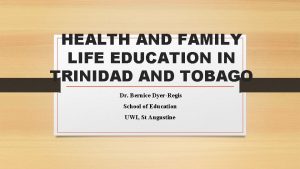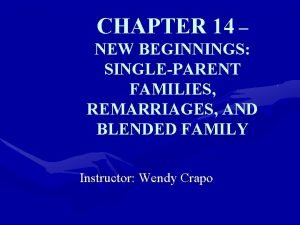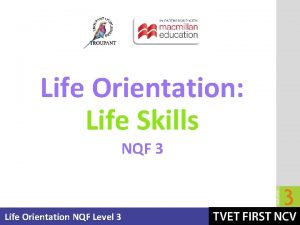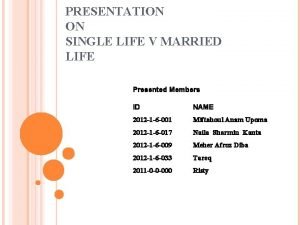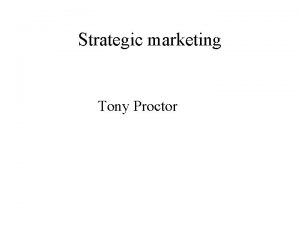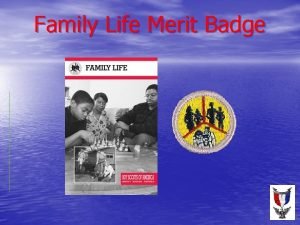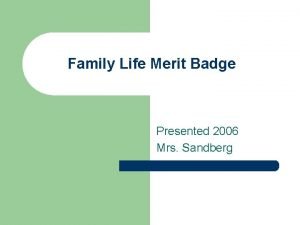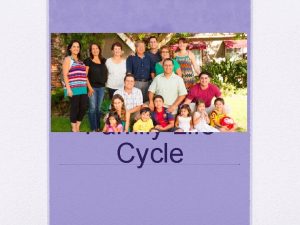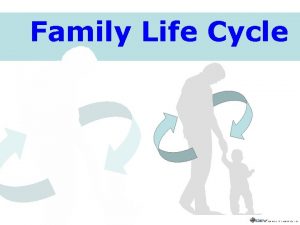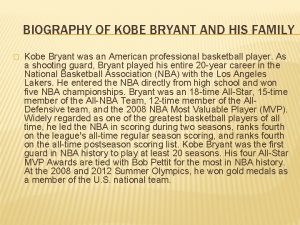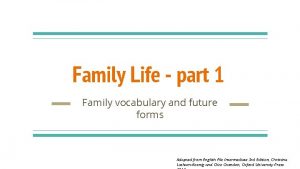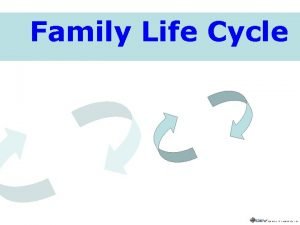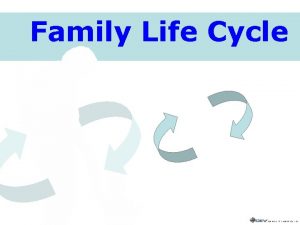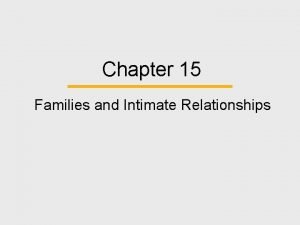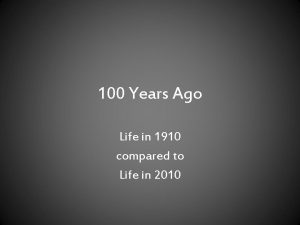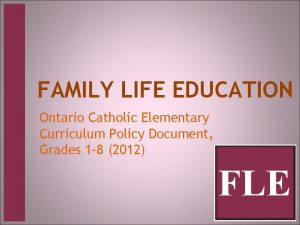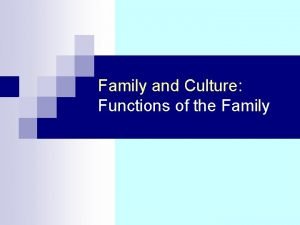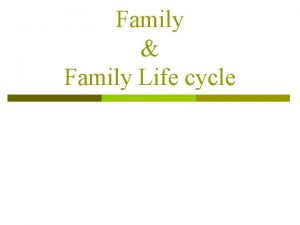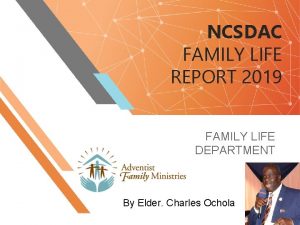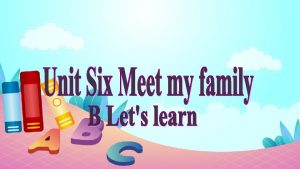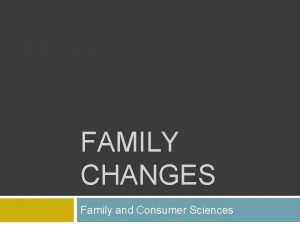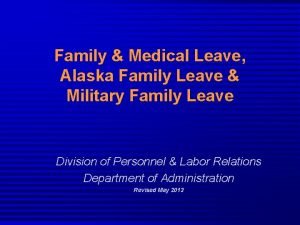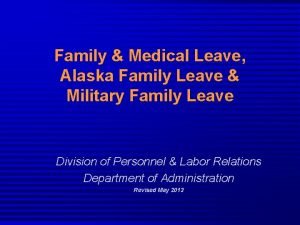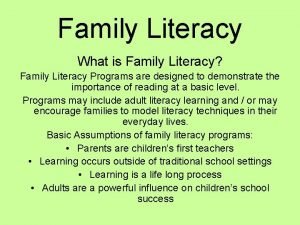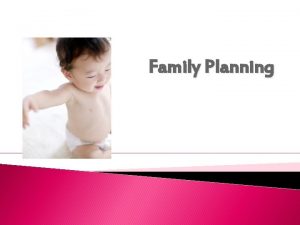F L A S H Family Life and



































- Slides: 35

F. L. A. S. H. Family Life and Sexual Health at the K-4 level it’s called All About Life If you could be born again and pick your gender, you would be _______ Stay the same _______ Change to the other gender Words & descriptions introduced to the children at this age: Vulva, vagina, clitoris, penis, scrotum, testicles

FLASH for 4, 5 and 6 Grade: The pornographic book, “It’s Perfectly Normal” is recommended for use now and on through the upper levels of the curriculum.


Family Life and Sexual Health, Grades 4, 5, and 6, Lesson 2 F. L. A. S. H. Activity 1. Explain that this lesson will help students explain what families are for, and how they (your students) contribute to their own families. 2. Define family. A family is two or more people who love and take care of each other. Usually they are related and/or live together. Families come in all shapes, sizes and descriptions. 3. OPTIONAL: Show the 35 -minute documentary film That’s A Family and discuss it. The film tells the stories, in their own words, of children in families with parents of different races or religions, divorced parents, a single parent, gay or lesbian parents, adoptive parents or grandparents as guardians. The film also does not introduce every configuration of family. Discuss which types of families were not portrayed (two-biological parent families, foster families and group homes, couples without children, bigger and extended families living together).

Family Life and Sexual Health, Grades 4, 5, and 6, Lesson 9 F. L. A. S. H. Crushes and attractions may begin (both) – Explain that although kindergartners may get crushes, too, they may feel more intense at puberty. It is the feeling of really wanting someone to like you. Of having your tummy feel funny when they walk in the room or when you hear their voice. Everybody will feel this eventually, but some people will notice it at this age and others may notice those kinds of feelings until middle school, high school or even later. A person may have crushes on people of their own sex, the other sex or both. It may or may not predict how they will feel when they’re grown. That is, really liking someone of a different sex doesn’t necessarily mean you will eventually figure out that you are a heterosexual (straight). And, likewise, really liking someone of your own sex doesn’t necessarily mean that you will eventually figure out that you are gay or lesbian. It often takes time to figure out. There’s no rush.


Family Life and Sexual Health, Grades 4, 5, and 6, Lesson 12 F. L. A. S. H. Reproductive System Worksheet 4 (words that students are to know the correct definition of) a. b. c. d. e. f. g. h. i. j. k. l. m. n. o. p. Circumcision Some of the definitions: Conception Ejaculation The penis or clitoris filling with blood and getting Erection harder and larger. Fertilization Genitals The penis being inside the vagina. Implantation Intercourse Semen coming out of the penis. Menstruation Nocturnal emission Ejaculation during sleep (sometimes called “having a Ovulation wet dream”) Ovum Pituitary Puberty Semen (Using these same words, students also play a Sperm vocabulary bingo game! How fun!)

Family Life and Sexual Health, Grade 7 and 8, Lesson 14 F. L. A. S. H. Activities: 1. Explain the relevance of today’s lesson. Explain that today’s lesson is focusing on PEOPLE, not just teens, and emphasize that you are not assuming that all your students - or even the majority - are having intercourse: Today's lesson is on birth control. We are doing this lesson for three reasons. Some people have intercourse in their teens. For them, knowing about birth control is important. That's one reason we're studying it. Other people choose not to have intercourse in their teens, but almost everyone - even those who wait until marriage or who are gay or lesbian - will have intercourse at some time in his or her life. So, the second reason we're doing this is that most of you will want to make decisions about birth control some day.

2. Brainstorm birth control methods, including abstinence. Brainstorm all the kinds of birth control anyone in the class has heard of. If they include nonmethods like douching (which doesn't work), male pills (which don't exist yet), or abortion (which doesn't prevent pregnancy and is therefore not counted as a method of birth control) list them separately from actual methods. This lesson will cover just 7 of the 17 methods (see endnote for an explanation of why we chose these 7 to focus on) available in the United States – those bolded in the list here – but write on the board any of these that students may know about, adding just the bolded ones they may forget or not have heard of: BEHAVIORAL: abstinence, withdrawal, fertility awareness, combining two methods (e. g. , condoms with a hormonal method, like the pill). BARRIER: “male” condom 3, “female” condom 4, diaphragm. HORMONAL: the pill, the patch, the vaginal ring, the shot (Depo-Provera), the implant (Implanon), hormonal IUD (Mirena intra-uterine device), emergency contraceptive (Plan B) pills. SPERMICIDES: foam, cream, gel, suppositories, tablets, film and the sponge. OTHER: copper IUD (intra-uterine device), sterilization.

3. Introduce 7 methods, focusing on what each is and how it reduces pregnancy risk. (Use the Birth Control Reference Sheets 1 and 2, and optionally display actual methods. ) Hand out the Birth Control Reference Sheet 1. Describe each of the 7 methods utilizing the Birth Control Reference Sheet 2 for speaker notes. Emphasis should be on what each method is and how it reduces pregnancy risk. It is probably not necessary in 7 th and 8 th grade to go into much detail about how a method is used, its benefits, its side effects, its medical risks, its cost, etc. If questions about these issues are asked, do answer them to the best of your knowledge (or say "I don't know"), but we don't recommend raising them yourself. If you have your district's approval, hold up each method as you describe it. We recommend this because students find them much easier to visualize if they can actually see them. We do not recommend passing the devices around. Very few middle school classes have sufficient maturity. If you do not consider yourself knowledgeable enough to do such a lecture/demonstration, it is fine to use a guest speaker – your school nurse or a family planning educator -- instead (see page 8 in your FLASH binder for suggestions regarding working with guest speakers).

6. Which methods can teenagers get without parental consent? All of these. . . which is not to imply that this is ideal Although we realize that in an ideal world every child could share this “coming-of-age” decision with his or her family, the law recognizes that some families can't / don't talk about sexual issues, and the most important thing is helping people prevent unintended pregnancy. The HIV section of the FLASH curriculum for 7 and 8 grade is where we see the introduction of information on and definitions of oral, and vaginal sex. Page 23 -9: “Anal intercourse” is the kind of sexual touch where one person’s penis is in the other person’s anus. Instructions for the teacher include: [Probably some students in your class will make inappropriate noises and comments at the idea of anal intercourse. It is important to not allow disrespectful remarks. Because people have diverse beliefs about intercourse, this would be an appropriate time to use the Values Question Protocol. ]

And, if that isn’t enough…. The HIV section of the FLASH curriculum for 7 and 8 grade also includes this: Dental dams are rectangular pieces of latex used to protect both partners when oral sex is performed on the genitals or anus. Page 23 -9:

F. L. A. S. H. : Family Life and Sexual Health: Grades 9 -12, 3 rd Edition











High School FLASH, 3 rd Edition Refusal Skills Scenario E Small-Group Practice Stacia and Grace are juniors in high school and have been best friends since the fifth grade. Grace has been with her girlfriend, Brooklyn, for 3 months and is in love. Grace doesn’t want to have sex with Brooklyn. She thinks that she is too young to have sex and doesn’t feel ready. Stacia started having sex with her boyfriend 2 months ago and is pressuring Grace to also have sex. (Be sure that in Grace’s responses to Stacia, she does not put Stacia down or call her any names for having made the decision to have sex. ) Stacia: I can’t believe that you haven’t had sex with Brooklyn yet. I don’t know why you’re waiting. You should just do it. Grace: ________________________________________________________________________________________

High School FLASH, 3 rd Edition Gender Expectations Scenarios Instructions: Complete the example scenario with the whole class. Be sure to fill in the answers on your sheet. You will complete one of the other scenarios with your group. Example: Bruno is feeling sad and hurt because his girlfriend broke up with him, but when his friends ask him how he is, he says he’s glad they broke up and that he never cared about her anyway. What traditional expectation of men is likely influencing Bruno’s actions? 1. On Saturday night, Aleesha had sex with her girlfriend even though she wasn’t in the mood because she didn’t want to hurt her girlfriend’s feelings. What traditional expectation of women is likely influencing Aleesha’s actions?

High School FLASH, 3 rd Edition Lesson 10 - Page 8 2. Explain purpose of lesson The purpose of this lesson is for students to learn that birth control is excellent at preventing pregnancy, regardless of whether they need to prevent pregnancy right now. Hand out the Sexual Health Resources. Give information about where teens can get birth control in your community, including whether it is confidential and free. We are learning about birth control because birth control is great at preventing pregnancy. Gay, lesbian, bisexual, and straight teens all need to learn about birth control and STD prevention. Some students need to know about how to prevent pregnancy right now because they’re having vaginal intercourse, or they will in the next few years.


High School FLASH, 3 rd Edition Condom information, condom pictures, condom demonstration, condom practice. Warm Up Choose one of the following statements and write 1 or 2 sentences about why you agree with it. Condoms are easy to get and easy to use. One great thing about condoms is that they prevent both pregnancy and STD’s. When I have sex, I will use condoms.

High School FLASH, 3 rd Edition 4. Discuss the effectiveness of condoms A condom is a thin stretchy cover that is worn over the penis. It can be used during oral, anal or vaginal sex. It greatly lowers the chance of giving or getting HIV or another STD. 5. Demonstrate correct condom use and have students practice Do not demonstrate with fruit or vegetables, as some people find this offensive…. 6. Demonstrate correct use of female condom


F. L. A. S. H. : Family Life and Sexual Health Grades 56, 7 -8, 9 -10, And 11 -12 Elizabeth Reis, M. A. Seattle-King County Department of Public Health, Seattle, WA • SIECUS Report: Sexual Orientation , V. 26 N. 4 www. siecus. org, 14 Mar 2000 [cached]These pieces include "A Guide to Teaching Actively About Sexual Orientation" by Beth Reis of the Seattle-King Country Department of Public Health in Seattle

Elizabeth (Beth) Reis

Brett Niessen


Kari Kesler Becky Reitzes
 Conclusion on topic family
Conclusion on topic family Hfle curriculum trinidad
Hfle curriculum trinidad Varies from family to family on the periodic table
Varies from family to family on the periodic table Characteristics of single parent family
Characteristics of single parent family City life and country life paragraph
City life and country life paragraph Slidetodoc.com
Slidetodoc.com Arranged marriage advantages
Arranged marriage advantages Unit 8 country life and city life
Unit 8 country life and city life Igbo family structure
Igbo family structure Family life cycle marketing
Family life cycle marketing Living a holy life
Living a holy life Family life requirements
Family life requirements Family life merit badge
Family life merit badge Parenting/expanding stage
Parenting/expanding stage Later parenthood stage
Later parenthood stage Kobe bryant childhood facts
Kobe bryant childhood facts Happiest moment with my family
Happiest moment with my family Family life vocabulary
Family life vocabulary Family life in ancient china
Family life in ancient china Wake up and pay attention
Wake up and pay attention Happy friday family
Happy friday family Family life today
Family life today Daily life roman empire
Daily life roman empire Family life today
Family life today Family life ministries themes
Family life ministries themes Family life 100 years ago
Family life 100 years ago Family life cycle stages
Family life cycle stages Family life curriculum ontario
Family life curriculum ontario What is family life in school
What is family life in school Roman empire family life
Roman empire family life Olmec technology
Olmec technology What is your personal definition of family
What is your personal definition of family Most important thing in life essay
Most important thing in life essay City life vs country life
City life vs country life Applying polynomials in real life
Applying polynomials in real life Country life vs city life compare /contrast
Country life vs city life compare /contrast

